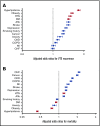Metabolic syndrome increases risk of venous thromboembolism recurrence after acute deep vein thrombosis
- PMID: 31917844
- PMCID: PMC6960475
- DOI: 10.1182/bloodadvances.2019000561
Metabolic syndrome increases risk of venous thromboembolism recurrence after acute deep vein thrombosis
Abstract
An improved understanding of which patients are at higher risk of recurrent venous thromboembolism (VTE) is important to designing interventions to reduce degraded quality of life after VTE. Although metabolic syndrome (MetS), the clustering of hypertension, hyperlipidemia, diabetes mellitus, and obesity has been associated with a hypofibrinolytic state, data linking VTE recurrence with MetS remain limited. The purpose of this study was to measure the prevalence of MetS in patients with deep vein thrombosis (DVT) across a large population and determine its effect on VTE recurrence. This was a retrospective analysis of a large statewide database from 2004 to 2017. We measured the frequency with which patients with DVT carried a comorbid International Coding of Diseases diagnosis of MetS components. Association of MetS with VTE recurrence was tested with a multiple logistic regression model and VTE recurrence as the dependent variable. Risk of VTE recurrence conferred by each MetS component was assessed by Kaplan-Meier curves with the log-rank statistic. A total of 151 054 patients with DVT were included in this analysis. Recurrence of VTE occurred in 17% overall and increased stepwise with each criterion for MetS. All 4 components of MetS had significant adjusted odds ratios (OR) for VTE recurrence, with hyperlipidemia having the largest (OR, 1.8), representing the 4 largest ORs of all possible explanatory variables. All 4 MetS variables were significant on Kaplan-Meier analysis for recurrence of VTE. These data imply a role for appropriate therapies to reduce the effects of MetS as a way to reduce risk of VTE recurrence.
© 2020 by The American Society of Hematology.
Conflict of interest statement
Conflict-of-interest disclosure: Indiana University has received funding from Janssen and Pfizer pharmaceuticals for investigator-initiated research by J.A.K. L.K.S. declares no competing financial interests.
Figures
Similar articles
-
Metabolic Syndrome Increases Risk of Venous Thromboembolism Recurrence after Acute Pulmonary Embolism.Ann Am Thorac Soc. 2020 Jul;17(7):821-828. doi: 10.1513/AnnalsATS.201907-518OC. Ann Am Thorac Soc. 2020. PMID: 32187500 Free PMC article.
-
Association between metabolic syndrome and venous thromboembolism after total joint arthroplasty: a meta-analysis of cohort studies.J Orthop Surg Res. 2020 Nov 30;15(1):570. doi: 10.1186/s13018-020-02097-4. J Orthop Surg Res. 2020. PMID: 33256765 Free PMC article.
-
Symptomatic perioperative venous thromboembolism is a frequent complication in patients with a history of deep vein thrombosis.J Vasc Surg. 2010 Sep;52(3):651-7. doi: 10.1016/j.jvs.2010.04.029. Epub 2010 Jun 16. J Vasc Surg. 2010. PMID: 20558025
-
Which patients are at high risk of recurrent venous thromboembolism (deep vein thrombosis and pulmonary embolism)?Blood Adv. 2020 Nov 10;4(21):5595-5606. doi: 10.1182/bloodadvances.2020002268. Blood Adv. 2020. PMID: 33170937 Free PMC article. Review.
-
The Overlooked Risk of Venous Thromboembolism in Psychiatric Patients: Epidemiology, Pathophysiology, and Implications for Clinical Care.Semin Thromb Hemost. 2025 Jun;51(4):430-437. doi: 10.1055/s-0044-1800968. Epub 2024 Dec 13. Semin Thromb Hemost. 2025. PMID: 39672190 Review.
Cited by
-
Elevated Risk of Venous Thromboembolism in People Living with HIV.Viruses. 2022 Mar 12;14(3):590. doi: 10.3390/v14030590. Viruses. 2022. PMID: 35336997 Free PMC article. Review.
-
Genetic Predisposition of Both Waist Circumference and Hip Circumference Increased the Risk of Venous Thromboembolism.Thromb Haemost. 2023 Mar;123(3):347-361. doi: 10.1055/a-1980-8852. Epub 2022 Nov 16. Thromb Haemost. 2023. PMID: 36384228 Free PMC article.
-
Changes in body mass index following venous thromboembolism in children: a prospective cohort study.Res Pract Thromb Haemost. 2025 Mar 13;9(3):102728. doi: 10.1016/j.rpth.2025.102728. eCollection 2025 Mar. Res Pract Thromb Haemost. 2025. PMID: 40337620 Free PMC article.
-
Metabolic syndrome, adipokines, coagulation factors, and venous thromboembolism: a two-step Mendelian randomization study.Diabetol Metab Syndr. 2025 Jun 4;17(1):190. doi: 10.1186/s13098-025-01763-z. Diabetol Metab Syndr. 2025. PMID: 40462212 Free PMC article.
-
Is Arsenic Exposure a Risk Factor for Metabolic Syndrome? A Review of the Potential Mechanisms.Front Endocrinol (Lausanne). 2022 May 16;13:878280. doi: 10.3389/fendo.2022.878280. eCollection 2022. Front Endocrinol (Lausanne). 2022. PMID: 35651975 Free PMC article. Review.
References
-
- Goldhaber SZ. Venous thromboembolism: epidemiology and magnitude of the problem. Best Pract Res Clin Haematol. 2012;25(3):235-242. - PubMed
-
- Cushman M, Tsai AW, White RH, et al. . Deep vein thrombosis and pulmonary embolism in two cohorts: the longitudinal investigation of thromboembolism etiology. Am J Med. 2004;117(1):19-25. - PubMed
-
- Park B, Messina L, Dargon P, Huang W, Ciocca R, Anderson FA. Recent trends in clinical outcomes and resource utilization for pulmonary embolism in the United States: findings from the nationwide inpatient sample. Chest. 2009;136(4):983-990. - PubMed
-
- White RH. The epidemiology of venous thromboembolism. Circulation. 2003;107(23 Suppl 1):I4-I8. - PubMed
-
- Carrier M, Le Gal G, Wells PS, Rodger MA. Systematic review: case-fatality rates of recurrent venous thromboembolism and major bleeding events among patients treated for venous thromboembolism. Ann Intern Med. 2010;152(9):578-589. - PubMed




